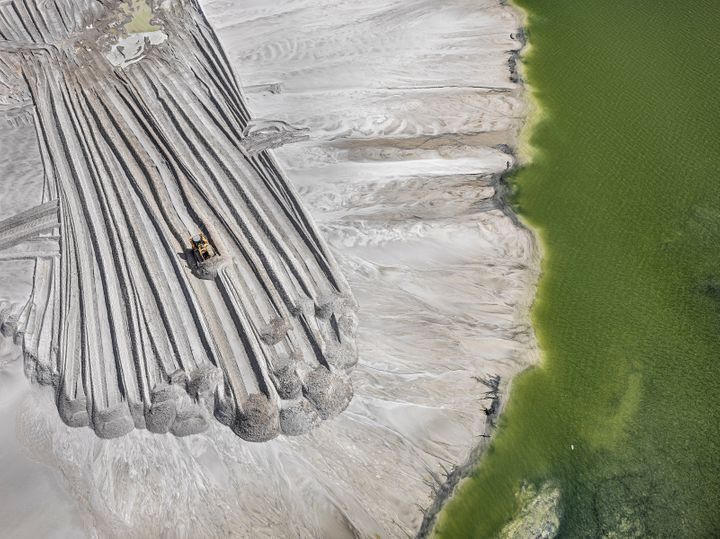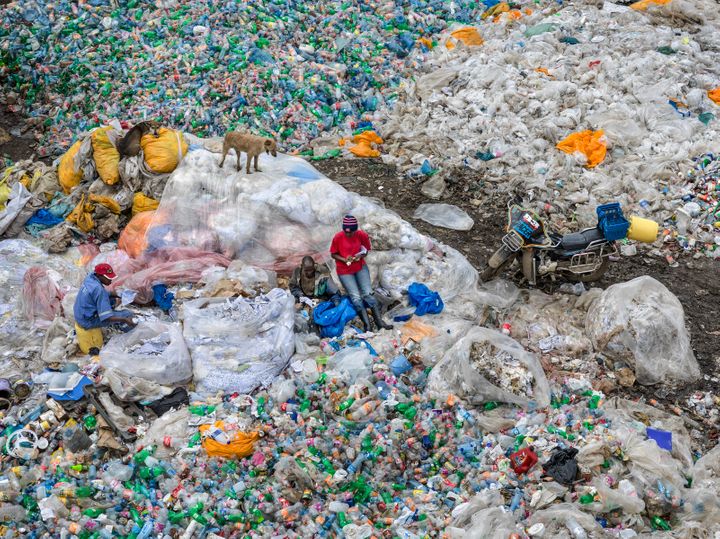[ad_1]
“Anthropocene: The Human Epoch,” a documentary by filmmakers Jennifer Baichwal, Nicholas de Pencier and photographer Edward Burtynsky, is a nature story gone awry, a dazzling and at times nauseating document of the far-reaching, and possibly catastrophic, impact that humans have had on the planet.
The film gets its title from the geological term “Anthropocene,” which was first coined in 2000 by atmospheric chemist Paul Crutzen and ecologist Eugene Stoermer. In 2016, a group of geologists called the Anthropocene Working Group proposed that our planet has recently been so drastically altered by human activity that we are now living in a distinct geological era. (That’s why it’s called the Anthro-pocene, because humans made it.) Humans had been getting by in the Holocene epoch for 11,000 years since the last glacial age, but the Anthropocene Working Group claims that through farming, industrialization, massive excavation of minerals and the dumping of ton after ton of trash, we’ve created a new geological era.
The filmmakers, who showed a few clips of the documentary at the United Nations Climate Action Summit this week, spent a little over three years in production, traveling to places that are emblematic of this new epoch. (The documentary will stream on Kanopy in January 2020.) “Anthropocene” is the third documentary in a trilogy, after “Manufactured Landscapes” and “Watermark,” about the ways that humans are wreaking havoc on the planet at an exponentially faster rate. Much of the imagery in “Anthropocene” is stunning to see and surreally beautiful. A worker wades into a pool of lithium with gradations of bright blue and yellow in the Atacama Desert in Chile. A slightly inadequate excavator struggles to lift a large square of marble from Italy’s vertigo-inducing quarry. The opening scene shows activists in Kenya burning 10,000 poached elephant tusks.

The accompanying statistics, narrated by Alicia Vikander, are no less staggering than the footage. By the year 2050, there will be more plastic in the water than fish. Each year, we lose approximately 18.7 million acres of forest. A tenth of the world’s wilderness has been lost in just two decades. The narration is spare but sobering.
So when exactly did we get so completely screwed? Scientists dispute the “beginning” of the Anthropocene. The Anthropocene Working Group proposes that it started sometime shortly after 1945, also known as the Great Acceleration. That’s when global travel increased dramatically, humans became more adept at both extracting resources and farming on an industrial scale, and started setting off nuclear bombs, which added artificial radionuclides to the atmosphere.
The film’s chapters correspond to the human activities that geologists say define the Anthropocene. One is terraforming the land for agriculture, urbanization and industrialization, another is extraction of minerals and anthroturbation, or tunneling, and yet another is technofossils which — get this! — are the concretes, 6 billion tons of plastic waste and technological detritus that will take millennia to break down. Earth’s waste is so massive that it will one day be its own layer in the planet’s geographical history for future generations to study just how many iterations of iPads we once chucked in the trash.
While much of the film captures landscapes from above and the harrowing mines and bleached coral reef below, the film does sometimes go to the ground and meet humans. The people in the film, almost all of them workers at these dangerous industrial sites, reflect on what living in manmade but wholly inhospitable landscapes is like. One worker at a heavy metal smelting factory in Norilsk, which has the dubious distinction of being Russia’s most polluted city, discusses adapting to the industrial landscape.

“Greenery is severely lacking here. Oxygen is too, as a result,” she said. “But when you adjust, it pulls you in, and it becomes your own. You see beauty in a flower that’s bursting through the stone.”
We’ve reached a point where it’s absurd to imagine individual behavioral changes making a dent in mitigating the worldwide devastation. Some humans are undoubtedly contributing the bulk of the destruction. The United States and China are the biggest culprits in terms of both emissions and waste and should adjust accordingly for the sake of the world. But activists and scientists agree that climate change must be addressed at the level of government and industry. The Intergovernmental Panel on Climate Change says we will eventually need to completely halt the burning of fossil fuels to avoid irreversible, cataclysmic damage to the earth’s atmosphere. That’s hard to imagine when you are gazing into the maw of Germany’s largest open-pit coal mine and watching a “Mad Max”-style terrestrial machine called the Bagger excavate coal by the hundreds of thousands of tons to burn.
“Anthropocene” makes an extremely compelling case, though imagery and statistics, that humans are responsible for the possibly irreversible damage done to the Earth and that, if we have the will and capacity for such massive alterations, we may also have the will and capacity to construct a more eco-friendly and sustainable world. It’s likely our only hope.
REAL LIFE. REAL NEWS. REAL VOICES.
Help us tell more of the stories that matter from voices that too often remain unheard.
[ad_2]
Source link

